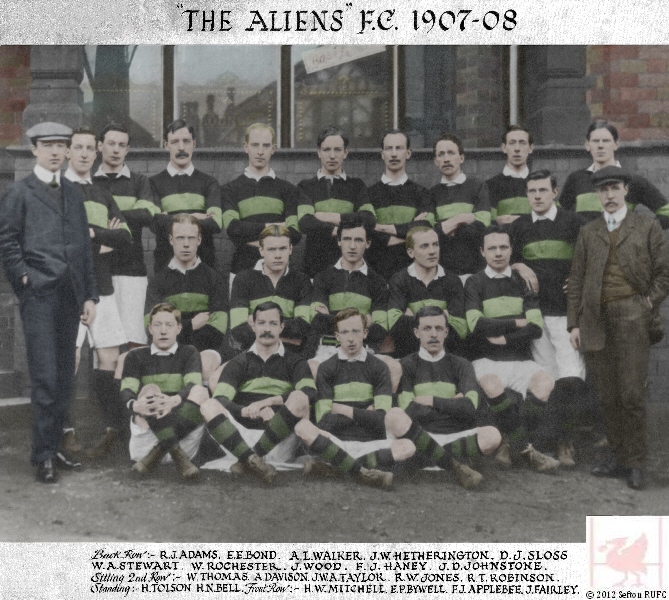
An Alien POW
Duncan John Sloss
Written and researched by David Bohl, with the kind help of Hong Kong University and World War 2 historians worldwide.
Born in Liverpool on the 19th June 1881 Duncan John Sloss became a founder member of The Aliens Rugby Union Club based at Clubmoor.
He went to Oulton School, which before 1906 was a pupil teacher's centre. These were in effect secondary schools for intending teachers and in 1906 it became a State Secondary School. After WW1 in 1919-1920 he held a William Noble Fellowship (English Literature) in the University of Liverpool. He went on to teaching appointments in the Universities of Liverpool and Leeds.
Mr. Sloss was responsible, in collaboration with Professor J. P. Wallis (then Professor of English in the University of Pretoria), for the publication of a critical edition of "The Prophetic Books" of William Blake (2 volumes, Oxford Press, 1926).
(Colours were black with an emerald hoop)

Aliens 2nd v University 2nd at Calderstones
Haney, Rumjahn, Ellis, Taylor, Robinson, O.Bayliss, H.Bayliss, Howe, Inglis, Lord, Owens, Parry, D.J.Sloss, W.Sloss, Williams, Brunskill
Liverpool Daily Courier 12th November 1910
Aliens make up large contingent at Teacher Conference 1909


University Residence 1911

[Ancestry.com]
Overseas Posting in India

[Passenger list 28th Dec 1912]
He had a distinguished career in the Indian Educational Service having served as Professor of English Literature first at His Highness the Maharaja’s College at Trivandrum in Travancore
The B.A. honours courses in English and History were started in 1914. Provision for the study of Natural Science (Biology) in the Intermediated Course was made in 1922. The school section of the institution continued to function in the same premises till 1919. In October of that year the school was shifted to a new building at Vanchiyoor and the whole of the old building was given over to the College. The strength of the college, that year, was 561. By 1923 it arose to 837 and there was great pressure for additional accommodation. Therefore in 1924 the Government decided to separate the Arts and Science Departments, This step, which is known as the bifurcations’ was given effect to at the beginning of the academic year 1924-25. The new institutions that came into being as result of the bifurcation were called H.H. The Maharaja’s College of Science and H.H. The Maharaja’s College of Arts. The later was housed in a new three storied building about a mile away at Thaikad. After the bifurcation, the Science College was affiliated for the B.A. pass course in Botany in 1924 for the B.A. Honours course in Mathematics in 1925 and for the B.A. pass course in Zoology in 1931. In the Arts College in B.A. Honours Course in Malayalam was started in 1935 and the B.A Honours Course in Sanskrit in 1939. The B.A. Course in Philosophy, though it was the first to be started in the old College, had to be discontinued for many years, as sufficient number of students was not forthcoming. It was however, re-started in 1925 in the Arts College. The strength of the Arts College in 1935-36 was 447 and that of the Science College 937.
Move to University of Rangoon 1920
In October 1920 the University of Rangoon was established with one of the first professors of the new university being D. J. Sloss (English).
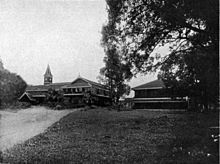
RANGOON UNIVERSITY Staff Listing
Biology . . . . F. J. Meggitt, M.Sc., Ph.D., F./.S., I.E.S. Geology and Geography (Vacant.) Medicine Surgery Pathology Anatomy Physiology Midwifery and Gynaecology Forensic Medicine Education Civil Engineering Forestry Law Lt.-Col. R. Kelsall, D.S.O., M.D., I.M.S. Lt.-Col. H. H. Scott, O.B.E., F.R.C.S.E., I.M.S. Major R. V. Morrison, M.D., I.M.S. Lt.-Col. L. A. H. Lack, M.B., Ch.B., I.M.S. (on leave) ; N. Ahmed, F.R.F.P. & S., L.M., M.B.B.S. (O/fg.) Major George R. Me Robert, M.D., M.R.C.P., D.T.M. & H., I.M.S. Lt.-Col. S. T. Crump, I.M.S. (on leave}-, Major M. L. Treston, F.R.C.S., I.M.S. (Offg.) Lt.-Col. T. F. Owens, I.M.S. G. F. Clark, M.A., Ph.D., I.E.S. (on leave) \ Miss M. E. Scott, M.B.E., M.A., B.Ed., I.E.S. (Offg.) W. N. Elgood, B.Sc., M.C., I.E.S. (on leave) ; A. J. Gould, B.Sc., I.E.S. (Offg) R. LJnwin, B.Sc., I.F.S. (on leave*) ; R. A. Cochrane, M.A., B.Sc., I.F.S. (O/fg.) A. Eggar, M.A., Bar-at-Law. Principal Anatomy Biology Constituent Colleges and their Staff. (1) University College). Constituent Colleges. (2, judson College ) * UNIVERSITY COLLEGE. .. D. J. Sloss, M.A.(Liv), C.B.E., I.E.S. (on leave) ; L. G. Owen, M.A., I.E.S. Wffg.) . . Professor : Lt.-Col. L. A. H. Lack, M.B., Ch.B. (Edin.). I.M.S. ( on leave) ; Professor N. Ahmed, F.R.F.P. & S., L.M., M.B.B.S., (Otfg.)', 1 Senior and 1 Junior Demonstrators. .. Professor: F. J. Meggitt, M.Sc., Ph.D. (Birm.), F.Z.S., I.E.S. One Lecturer and 3 Assistant Demonstrators.
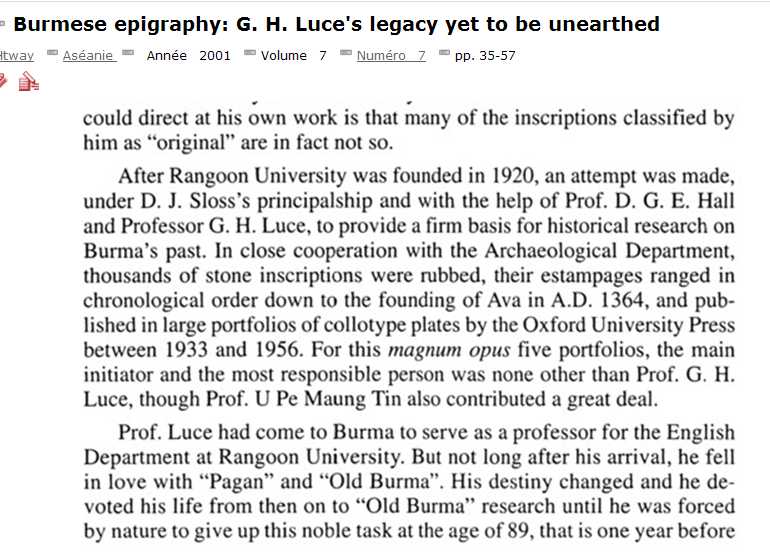
Established in 1878 as an affiliated college of the University of Calcutta, Rangoon College was operated and managed by the Education Syndicate set up by the British colonial administration. The college was renamed Government College in 1904, and University College in 1920. Rangoon University was founded in 1920, when University College (secular) and Judson College (Baptist-affiliated) were merged. The American Baptist Mission decided to recognise Judson College (formerly Baptist College) as a separate institution within Rangoon University. Rangoon University modelled itself after University of Cambridge and University of Oxford. All subsequent institutions of higher learning founded by the British were placed under Rangoon University's administration: Mandalay College in Mandalay in 1925, Teachers Training College and Medical College in Yangon in 1930, and Agriculture College in Mandalay in 1938.
Although it was attended only by the elites of the day, the university nonetheless was at the centre of anti-colonial movement. All three nationwide strikes against the British colonial government (1920, 1936 and 1938) began at the university. By the 1930s, the university was the hotbed of Burmese nationalism, producing a number of future senior Burmese politicians, including Aung San, U Nu, Ba Maw, Kyaw Nyein, Ba Swe, U Thant and Thein Pe Myint.
London Gazette 1925

Passenger Lists
Departure: Rangoon, Burma Arrival: 15 Jan 1925 - Southampton, England
Departure: Rangoon, Burma Arrival: 2 Nov 1928 - London, England
Departure: Manaos, Brazil Arrival: 26 Feb 1932 - Liverpool, England
Departure: Rangoon, Burma Arrival: 21 Jul 1936 - London, England Other: Cochin
1936- The third university boycott occurred. In 1936, the British government granted Burma permission to form a new administration. Most of the legislative members were elected, however, the governor had veto power, and authority to appoint cabinet member. RUSU’s chairman Ko Nu gave an anti-British speech encouraging students to fight not only for student rights but also for independence. One of the articles from the Oway Magazine that was published by RUSU made universities authorities angry. They said the articles criticised the British administration and the authorities of the university at that time. British authorities gave an order to Rangoon University administrator D.J Sloss to take action against the writer. Sloss demanded that Aung San, the chief editor of the magazine, reveal the name of the writer. Aung San refused to comply claiming that it did not agree with his editorial ethics. Ko Nu was expelled from the university. The university students went on strike. After three months a second university boycott occurred on May 8 1936. There was an all Burma students conference held at the Jubilee Hall, Rangoon. Student representatives from thirty-five towns, university boycotters and many observers enthusiastically attended the conference. Ma Khin Mya of the university moved to establish branches in the schools. This motion was seconded by Ma Thoung Shin of Gyobingauk Township (lower Burma) and Ma Thein Kyi of Bassein Township (Delta Area of Burma) and was unanimously passed. According to Ma Khin Mya, unions needed to be organized at the schools since a network of unions would provide the best organizational framework to safeguard the students’ interests and work in the interest of Burma’s progress towards independence. This proposal marked the first time a woman had initiated a major organizational resolution. During the conference, All Burma Students’ Union (ABSU) was established. Ko Raschit was the first chairman and Ko Aung San became the vice chairman. After ABSU was established, student unions were formed in secondary schools (Grade 7 to Grade 10) throughout the country. ABSU members promoted awareness of the adverse impact of colonial rule in Burma, the socio-economic situation and the longing for independence from the British. They effectively organized people and were able to work together with other organizations as well as political organizations struggling for independence. The National University was reopened.

The Straits Times 1937
UNIVERSITY OF HONG KONG.
Appointment of New Vice-Chancellor.
Mr. D. J. Sloss, C.B.E. MA., has been appointed to succeed Sir William Hornell, C.I.E., LL.D., MA., as Vice-Chancellor of the University of Hong Kong. Mr. Sloss was educated at Oulton School, Liverpool, and at the University of Liverpool. He had a distinguished career in the Indian Educational Service having served as Professor of English Literature first at His Highness the Maharaja’s College at Trivandrum in Travancore and then at the University of Rangoon. He was, for many years, Principal of University College, Rangoon. He took a leading part in the organisation and establishment of the University of Rangoon and was awarded the CBE in recognition of his services.
Prior to his service in India and Burma Mr. Sloss held teaching appointments in the Universities of Liverpool and Leeds. In 1919-1920 he held a William Noble Fellowship (English Literature) in the University of Liverpool. He has also had considerable teaching experience in schools in England.
Mr. Sloss was responsible, in collaboration with Professor J. P. Wallis (now Professor of English in the University of Pretoria), for the publication of a critical edition of "The Prophetic Books" of William Blake (2 volumes, Oxford Press, 1926).
Mr. Sloss is expected to arrive in Hang Kong during the latter part of October.
UNIVERSITY OF HONG-KONG
Founded 1911
PATRON H.M. THE KING.
CHANCELLOR H.E. THE GOVERNOR OF HONG-KONG.
VICE-CHANCELLOR AND PRINCIPAL D. J. SLOSS, C.B.E., M.A. Liv.
REGISTRAR S. V. BOXER, B.Sft. Edin.
Vice-Chancellors
1912–1918 .. .. .. Sir Charles Eliot, GCMG, CB, MA, DCL, LLD
1918–1921 .. .. .. G.P. Jordan, LLD (Acting)
1921–1924 .. .. .. Sir William Brunyate, KCMG, MA, LLD
1924–1937 .. .. .. Sir William Hornell, CIE, MA, LLD
1937–1949 .. .. .. D.J. Sloss, CBE, MA, LLD
1949–1964 .. .. .. Sir Lindsay Ride, CBE, ED, MA, DM, LLD, JP
1964–1965 .. .. .. W.C.G. Knowles, CBE, MA, LLD, JP
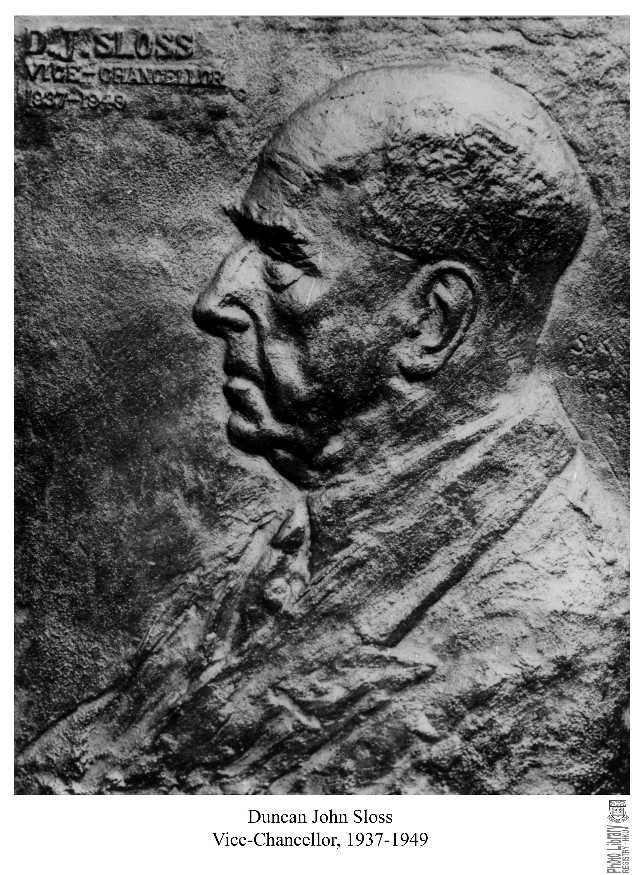
Sculpture 1939 by G.T.Chan
Photograph courtesy of HKU
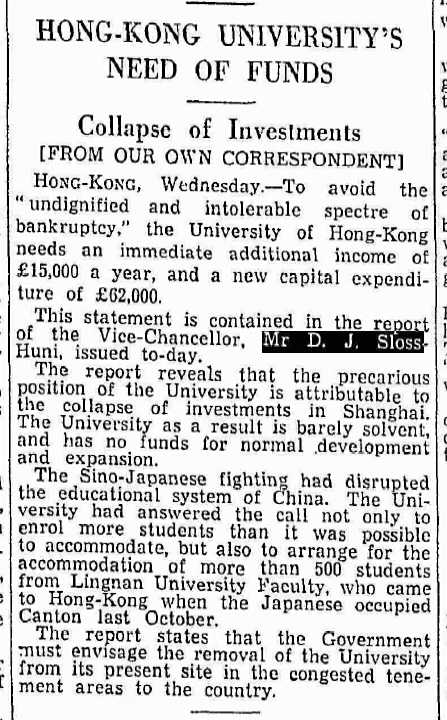
[June 1939]
Tributes to Dr John Sampson at Liverpool University Library - 1939

Dispersal and Renewal: Hong Kong University During the War Years
edited by Clifford N. Matthews, Oswald Cheung 1998
An Academic Odyssey A Professor on Five Continents - Norman H. Mackenzie
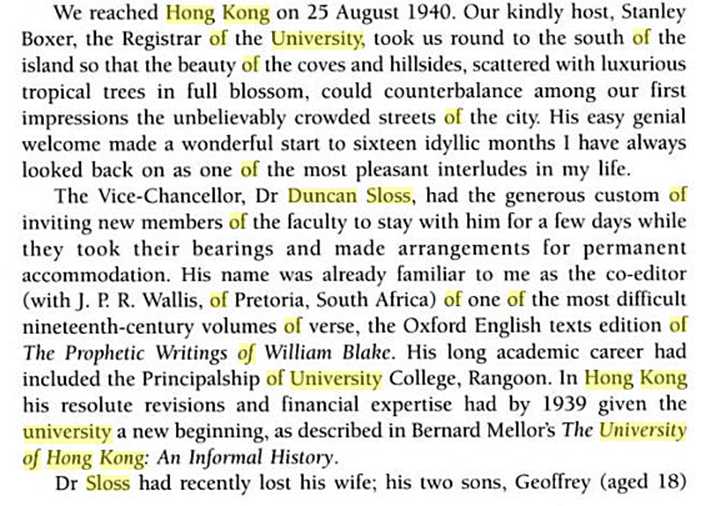
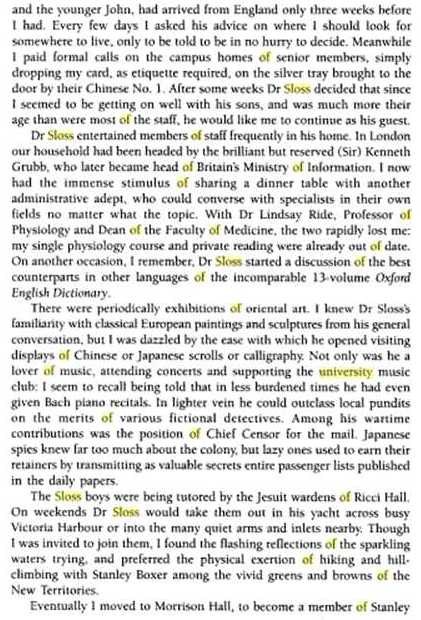
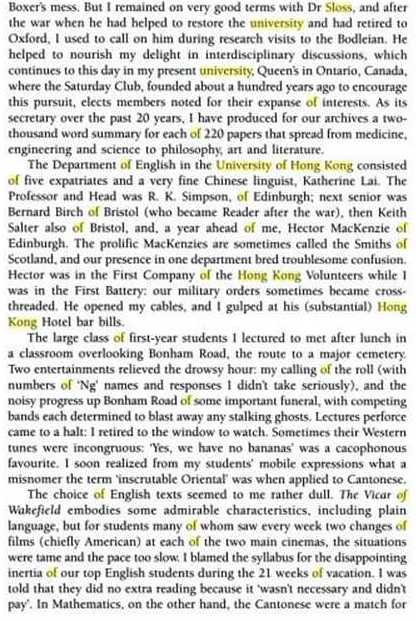
New Delhi. 25 October 1940 Eastern Group Supply Conference

[from Australian War Memorial]
Group portrait of delegates to an Eastern Group Supply Conference held to discuss the supply of munitions and other goods. This conference led to the setting up of the Eastern Group Supply Council, permanently in session at New Delhi, with representatives from the United Kingdom, India, Australia, South Africa and New Zealand, plus a representative of the Army Council and Imperial General Staff, who, after a Central Provision Office had decided questions such as priority of needs and other military details, brought before the Council the demands of the forces in the eastern Group. The Council then had to decide from which country or countries it would be best to obtain supplies.
Left to right, 1st row (sitting):
Honourable (Hon) Mr H. Dow (India); Hon D. B. Sir A. Ramaswami Mudaliar (India); Hon Sir Jeremy Raisman (India); F. J. Fahey (South Africa); Major (Maj) R. Stuttaford (South Africa); Major R. Stratford (South Africa); P. Furness (South Africa); H. R. Gollan (Australia); T. Donaldson (Australia); V. Smith (Australia); N. K. S. Brodribb (Australia); G. Walsh (Palestine); Sir Philip Mitchell (East Africa); Hon Sir Paw Tun (Burma); Sir Alexander Roger (Roger Mission); F. R. Picot (New Zealand);
Hon Sir Muhammed Zafrulla Khan (India); H. E. The Viceroy; Hon Sir Walter Massy-Greene (Australia, leader of the Australian delegation); Major General F. R. G. Hoare (South Africa); Hon Mr H. J. Huxham (Ceylon); Captain the Hon F. E. Harris (Southern Rhodesia); H. North-Hunt (Malaya); D. J. Sloss (Hong Kong); J. R. Middleton (New Zealand); Major H. E. Erridge (New Zealand); A. B. Taylor (New Zealand); G. H. Locock (Roger Mission); H. Heath (Roger Mission); H. W. L. Kearns (Roger Mission); F. Lydall (Roger Mission);O. W. Stickland (Roger Mission); P. S. Macdonald (Roger Mission); General Sir Clement Armitage (India); and Lieutenant Colonel (Lt Col) E. G. Cook (Mid East).
Second row (standing): G. Musgrave (Southern Rhodesia); Hon Mr J. B. Pandya (East Africa); Hon Mr J. H. McQuade (East Africa); Diwan Bahadur C. S. Ratnasabapathy Mudaliar (India); Captain H. Bertin (Southern Rhodesia); Hon Mr G. C. S. Corea (Ceylon); M. Venkatanaranappa (India); J. S. Smith (India); Miss Hoare (South Africa); Miss P. North-Hunt (Malaya); Sir Ness Wadia (India); Sir William Barton (Roger Mission); Brigadier B. H. Penn (Roger Mission); F. H. Harrison (Roger Mission); Lt Col T. E. Robins (Southern Rhodesia); Sir Abdul Halim Ghuznavi (India); L. Shri Ram (India); Amrit Lal Ojha (India); Fazal Ibrahim Rahimtoolah (India); J. G. Laithwaite (P.S.V.); Lt Col B. MacMahon (M.S.V.); J. J. Ghandy (India); Lt Col E. W. Slaughter (India); K. B. Syed Maratib Ali (India); W. A. Fell (Malaya); Hon Mr Tay Lian Teck (Malaya); D. L. Newbigging (Hong Kong); E. M. Jenkins (Secretary General); John Whyatt (Hong Kong); E. Cock (Hong Kong); P. F. S. Warren (India); Biren Mookerjee (India); G. B. Morton (India); Frederic Stones (India); R. Menzies (India); Hon Mr G. F. Clay (East Africa); Julius Jacobs (Palestine); and Hon Mr R. V. Stone (East Africa). Third row (standing): A. H. Seymour (Burma); Col E. Wood (India); A. S. Roger (Roger Mission); Sir Guthrie Russell (India); Maj Hon F. W. Cavendish-Bentinck (East Africa); D. H. Balfour (Ceylon); Hon Mr J. Baxter (Burma); Professor C. G. Beasley (Burma); J. Walker (Roger Mission); J. L. Knott (Australia); Barclay Leechman (East Africa); C. R. Anderson (South Africa); Captain J. Mathews (Roger Mission); H. M. Mathews (Roger Mission); J. H. S. Richardson (India); H. T. Maclachlan (Southern Rhodesia); S. Oldfield (Roger Mission); D. McKenzie (Roger Mission); A. O. Tookey (Roger Mission); W. D. Tomkins (Roger Mission); F. J. Hollies (Roger Mission); F. W. Leake (Roger Mission); S. V. Woolley (Roger Mission); W. G. A. Cook (Ceylon); N. U. Jayewardena (Ceylon); D. Harrison (Roger Mission); H. J. E. Hewlett (Roger Mission); Maj J. P. Acworth (Assistant to Joint Secretaries); Lt Col E. S. B. Gaffney (Joint Secretary); Maj L. R. Knight (Staff Officer); J. A. Mackeown (Joint Secretary); S. H. Y. Oulsnam (Secretary); A.D.C. to H. E.; A.D.C. to H.E.; A.C. Das (Assistant Secretary). (Original stored in AWM Archive Store.)
London Gazette 1941
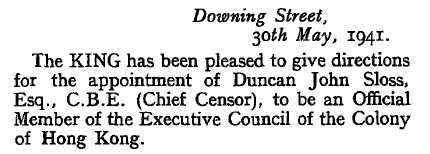
By Kennedy Hickman
British
Governor Sir Mark Aitchison Young Major General Christopher Maltby 14,000 men
Japanese
Lieutenant General Takashi Sakai 52,000 men
As the Second Sino-Japanese War raged between China and Japan during the late 1930s, Great Britain was forced to examine its plans for the defence of Hong Kong. In studying the situation, it was quickly found that the colony would be difficult to hold in the face of a determined Japanese attack. Despite this conclusion, work continued on a new defensive line extending from Gin Drinkers Bay to Port Shelter. Begun in 1936, this set of fortifications was modelled on the French Maginot Line and took two years to complete. Centred on the Shin Mun Redoubt, the line was a system of strong points connected by paths.
In 1940, with World War II consuming Europe, the government in London began reducing the size of the Hong Kong garrison to free troops for use elsewhere. Following his appointment as Commander-in-Chief of the British Far East Command, Air Chief Marshal Sir Robert Brooke-Popham requested reinforcements for Hong Kong as he believed even a marginal increase in the garrison could significantly slow down the Japanese in case of war. Though not believing that the colony could be held indefinitely, a protracted defence would buy time for the British elsewhere in the Pacific.
In 1941, Prime Minister Winston Churchill agreed to dispatch reinforcements to the Far East. In doing so, he accepted an offer from Canada to send two battalions and a brigade headquarters to Hong Kong. Dubbed "C Force," the Canadians arrived in September 1941, though they lacked some of their heavy equipment. Joining Major General Christopher Maltby's garrison, the Canadians prepared for battle as relations with Japan began to falter. Having taken the area around Canton in 1938, Japanese forces were well positioned for an invasion. Preparations for the attack began that fall with troops moving into position.
Around 8:00 AM on December 8, Japanese forces under Lieutenant General Takashi Sakai began their attack on Hong Kong. Commencing less than eight hours after the attack on Pearl Harbour, the Japanese quickly gained air superiority over Hong Kong when they destroyed the garrison's few aircraft. Badly outnumbered, Maltby elected not to defend the Sham Chun River line at the colony's border and instead deployed three battalions to the Gin Drinkers Line. Lacking sufficient men to fully man the line's defences, the defenders were driven back on December 10 when the Japanese overran the Shing Mun Redoubt.
The rapid breakthrough surprised Sakai as his planners had anticipating needing a month to penetrate the British defences. Falling back, Maltby began evacuating his troops from Kowloon to Hong Kong Island on December 11. Destroying harbour and military facilities as they departed, the final Commonwealth troops left the mainland on December 13. For the defence of Hong Kong Island, Maltby re-organized his men into Eastern and Western Brigades. On December 13, Sakai demanded that the British surrender. This was promptly refused and two days later the Japanese began shelling the island's northern shore.
Another surrender demand was rejected on December 17. The next day, Sakai began landing troops on the island's north eastern coast near Tai Koo. Pushing back the defenders, they were later guilty of killing prisoners of war Sai Wan Battery and Salesian Mission. Driving west and south, the Japanese met heavy resistance over the next two days. On December 20 they succeeded in reaching the south coast of the island effectively splitting the defenders in two. While part of Maltby's command continued the fight on the western part of the island, the remainder was hemmed in on the Stanley Peninsula.
On Christmas morning, Japanese forces captured the British field hospital at St. Stephen's College where they tortured and killed several prisoners. Later that day with his lines collapsing and lacking critical resources, Maltby advised Governor Sir Mark Aitchison Young that the colony should be surrendered. Having held out for seventeen days, Aitchison approached the Japanese and formally surrendered at the Peninsula Hotel Hong Kong
Internment at Stanley with his Son
Sloss, D.J. 60, Vice-Chancellor
Sloss, John 16, Schoolboy
By Tom A. O'Donoghue, Clive Whitehead
It would have been hard indeed for such a man, scared as he was of what might happen to him, to refuse to help when so many others were running huge risks: academics like the ailing literary scholar, D. J. Sloss, for example, who was the first inmate of Stanley camp to receive communications from the British Army Aid Group, or women like Jean Gittins, who unhesitatingly agreed to translate into Chinese a message that was to be sent out of Stanley Camp by a route known to be compromised even though she was warned she’d be executed if the message were discovered. The bankers – the other main group of Allied civilians left outside Stanley. These men were the elite of Hong Kong, living in expensive homes on the Peak or other exclusive areas, and if such men were willing to risk agony and death to help their fellows in Stanley Camp.
Submitted by Brian Windsor Edgar on Wed, 2012-04-25 17:32
Book / Document: Chronology of Events Related to Stanley Civilian Internment Camp
Date of events described: Thu, 1942-07-02
Colonel Lindsay Ride escaped from Shamshuipo on January 9, 1942 and founded the British Army Aid Group, a resistance organisation based in Free China. On July 2, 1942 he sent a message to the former Vice-Chancellor of Hong Kong University, Duncan Sloss:
This is an attempt to set up a regular news service between us. Relatives all over the world are very anxious to hear of you all and I trust this will be the quickest and safest method of getting news in and out. The Priestwood-Thompson party brought the British list but not the American or Dutch; at any rate that list is no doubt out of date and it was not altogether accurate. An up-to-date list...is very badly needed and also a report on the treatment, conditions and casualties in the camp. I am trying to arrange on the quiet the 'escape' or liberation of all children....
I understand you need money badly. Here is $100 from me as a trial; if it gets through you will know that the route is trustworthy, in which case I suggest those who want money from homes should send me written authority to get money from their banks at home and I shall do my best to get it in.
Duncan Sloss, widowed in 1940 and in poor health, accepts Ride's proposal of regular communication. This is an act of great courage - there were few more dangerous 'jobs' in Camp than link with the resistance.
Sources:
The full message from Lindsay Ride can be read in Edwin Ride, British Army Aid Group, 1981, 134-135
Sloss' acceptance: George Wright-Nooth, Prisoner of the Turnip Heads, 1994, 114
Death of Mrs. Sloss: Hong Kong Daily Press, February 20, 1940
Let’s look at some individual examples of what Hong Kong University faculty and students experienced during the war. Lindsay Ride was a professor of physiology at the University and, during the war, commanded the medical unit of the Volunteers.
He became a prisoner of war at Sham Shui Po, but not for long. With the help of his assistant Y.P. Lee, who brought a boat to the Sham Shui Po waterfront, he escaped through barbed wire and they made their way to Free China. There Ride founded the British Army Aid Group, an intelligence unit that operated in South China throughout the war. After the war, he rejoined the University, which had just been restarted by Vice Chancellor Duncan Sloss, and was elected the new vice Chancellor, a position he held for 15 very active years, during which he promoted the rapid growth of the university.
Duncan Sloss himself was interned at Stanley. My mother and sister were also there, and remember well his inspiring intellectual presence. My sister even took a Shakespeare course with him.
It gave them a short but useful breathing space, time to make and carry out decisions which eased the lives of all the students in final year and of many others. It gave Sloss an opportunity to generate morale among his staff, of strength enough to take them, or most of them, through the debilitating trials of internment, of which much has been written elsewhere, and to show that it was ...
After the interval of shock and the counting of dead and dying, the Japanese capitulated on the 14th August. The University began reassembling immediately, from internment and prisoner-of-war camps, and from China. Duncan Sloss made for Pokfulam forthwith to take preliminary stock of the situation. However prepared he was for the sight, his impression must have been ...
By July 1942 the BAAG was ready to move, and Ride sent a letter into Stanley to Duncan Sloss, the Vice-Chancellor of Hong Kong University. This began a regular series of contacts using Chinese agents who in turn recruited people whose work took them into Stanley, for example truck drivers. This will become significant when we return to Thomas’s story in the next post. The University Senate decided, at a meeting on December 31, 1941, to confer degrees in medicine on the students whose examinations were interrupted by the Japanese invasion of Hong Kong. This is a photo taken on New Year’s Day 1942 behind Eliot Hall after the clandestine degree ceremony.
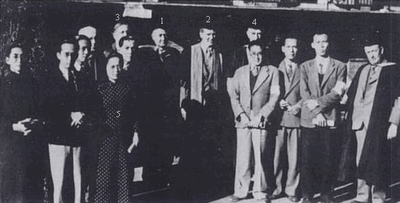
1. Professor Robertson
2. Gordon King, Dean, Faculty of Medicine
3. Duncan Sloss, Vice-Chancellor
4. Professor Kenelm Digby, Professor of Surgery
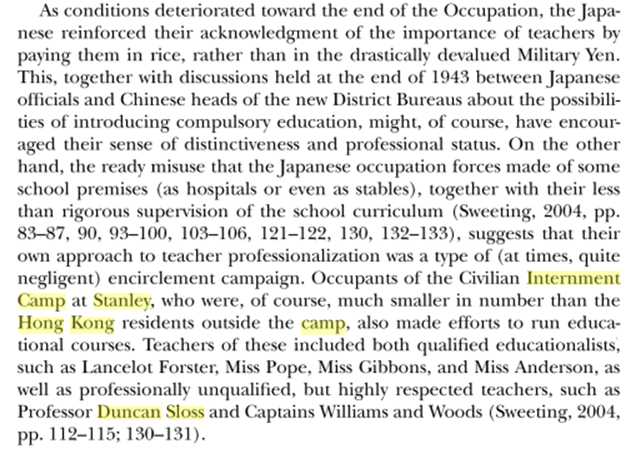
Hong Kong Sessional Paper No.8
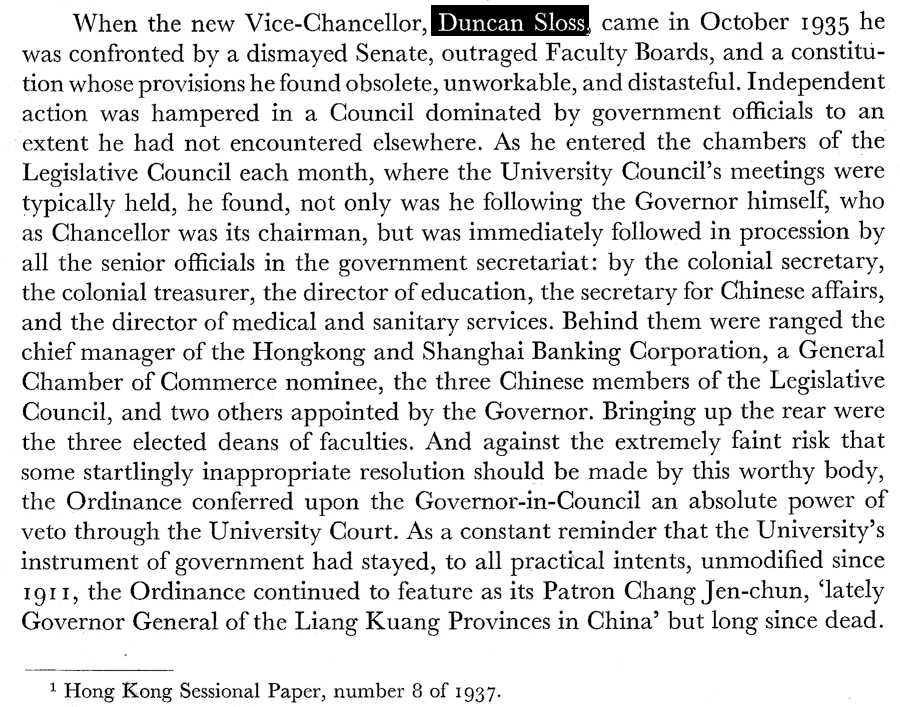
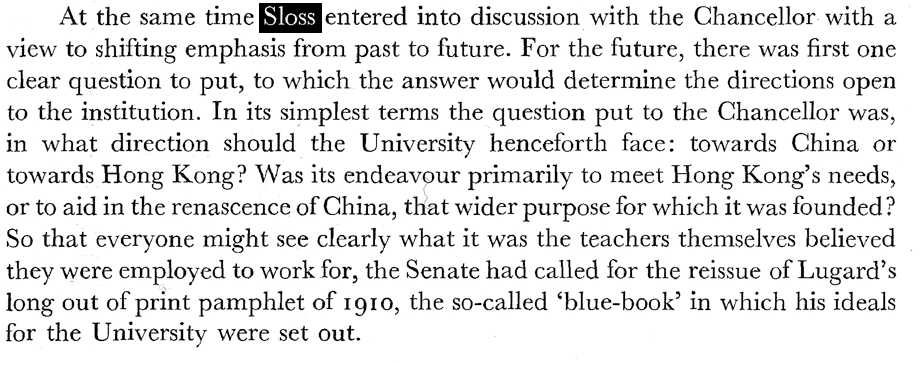
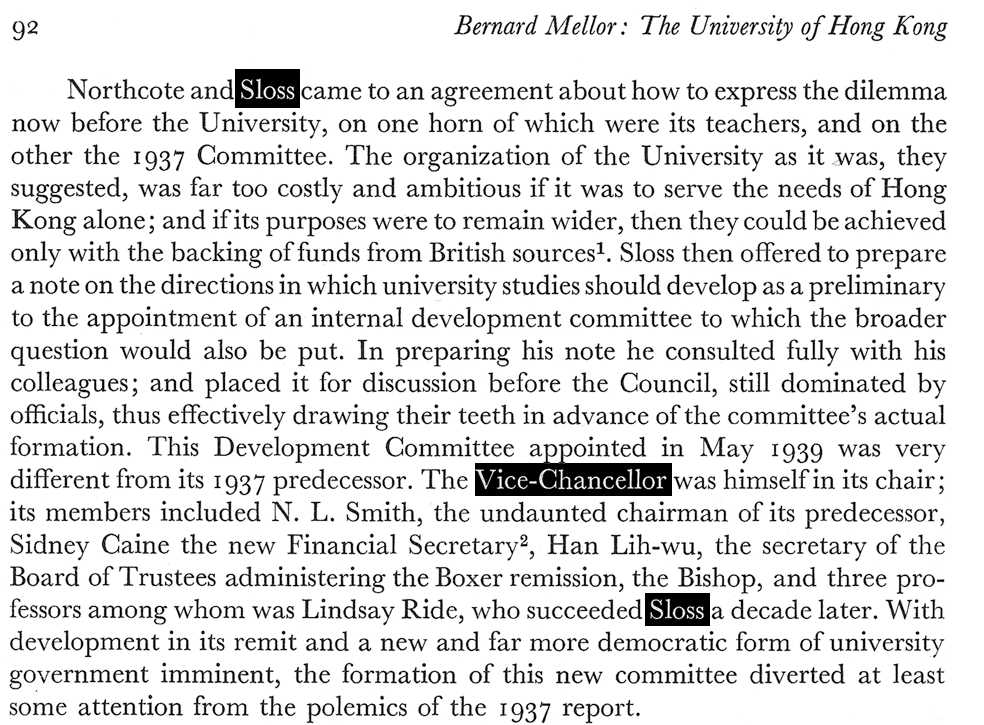
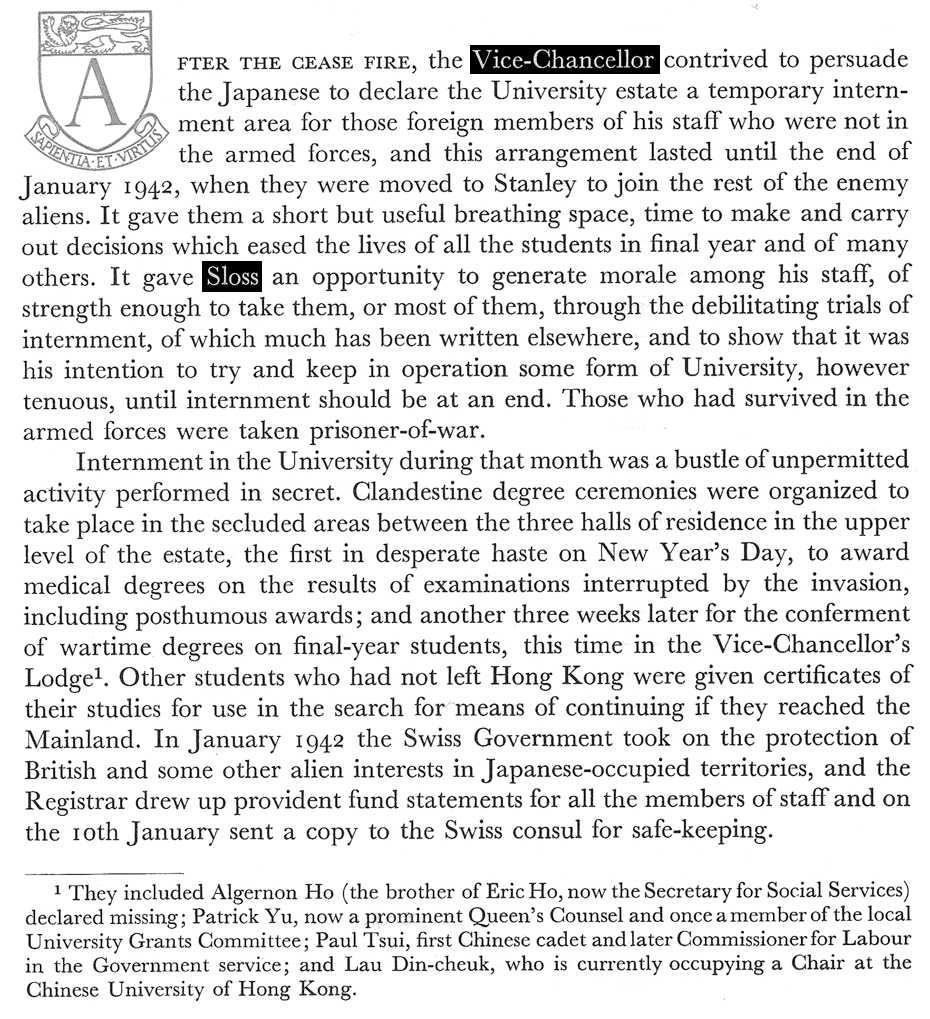
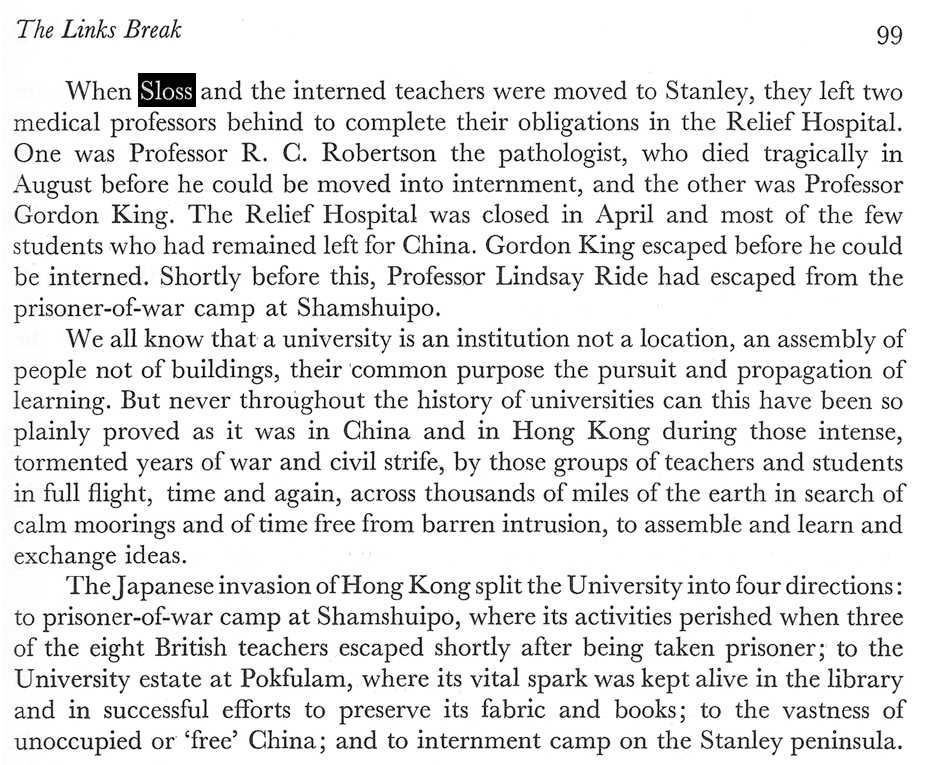
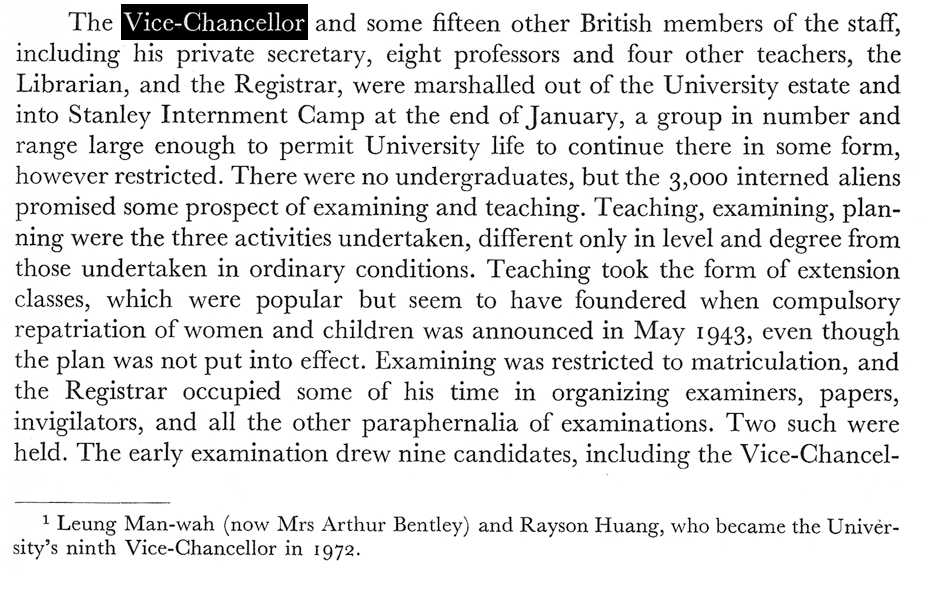
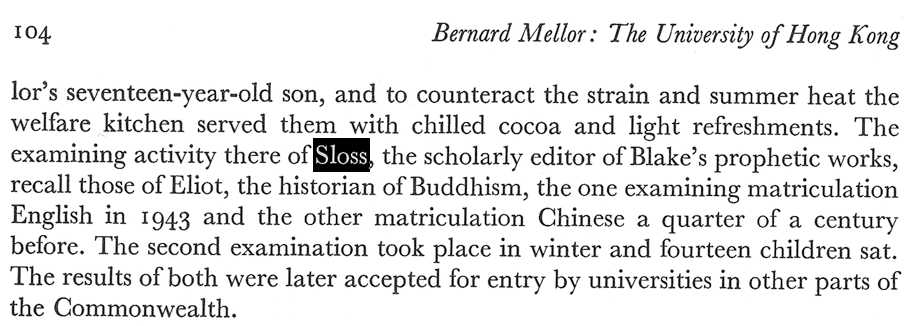
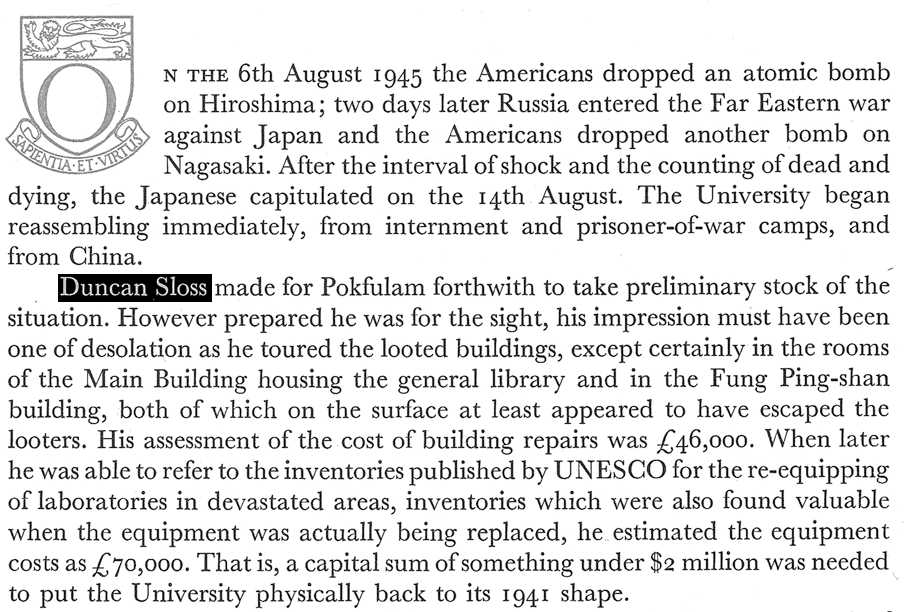
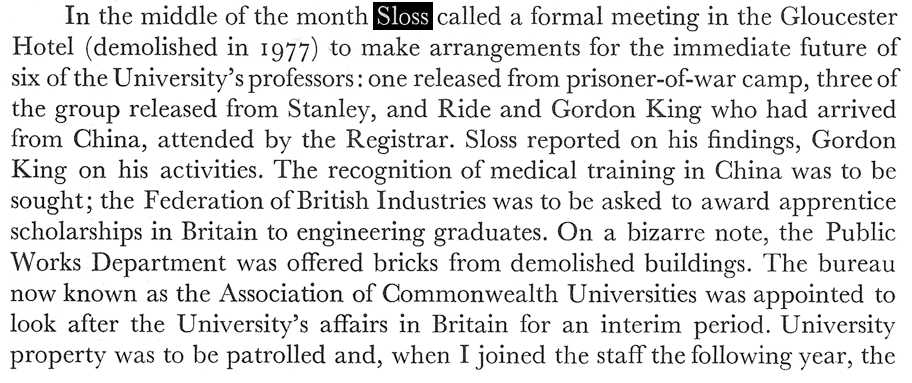
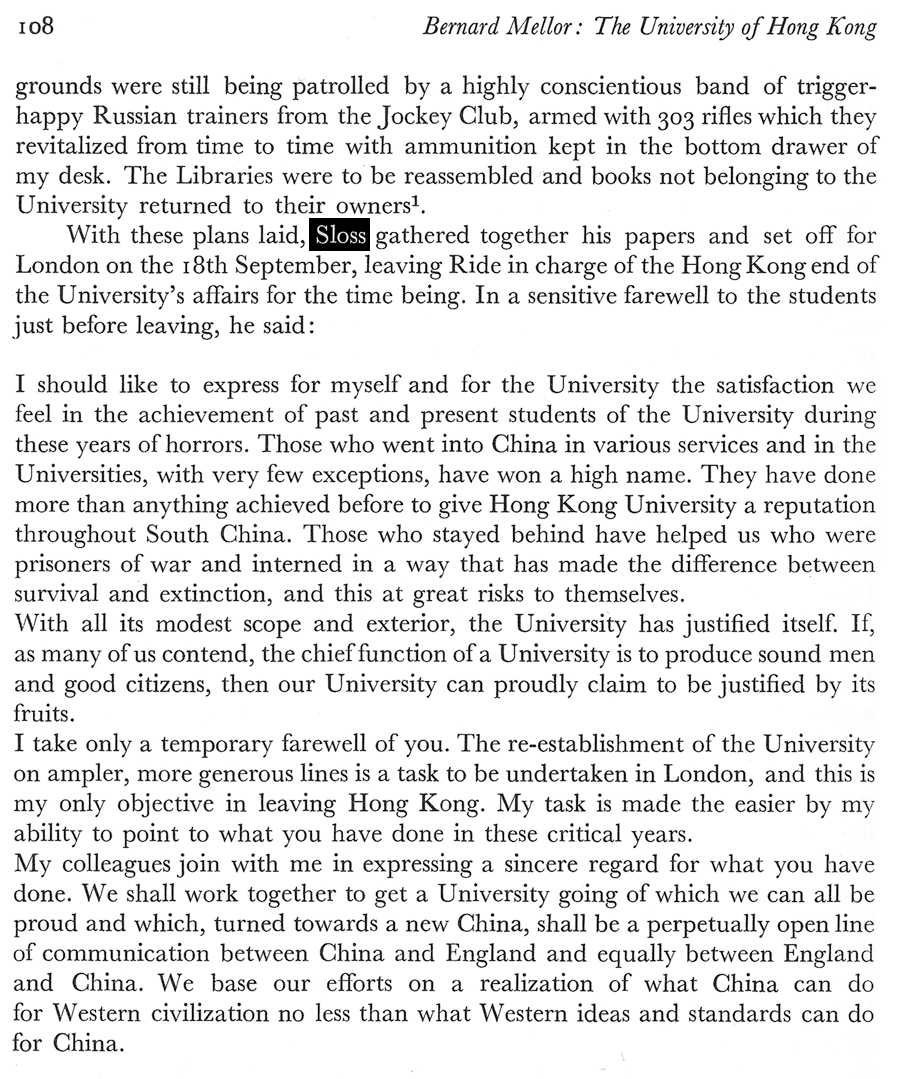
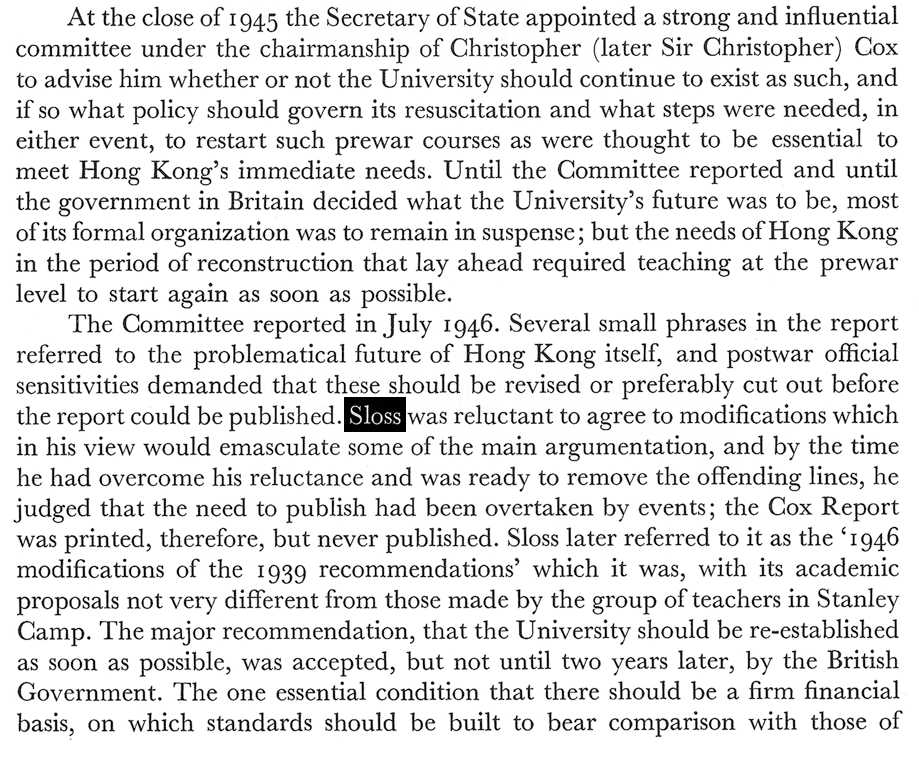
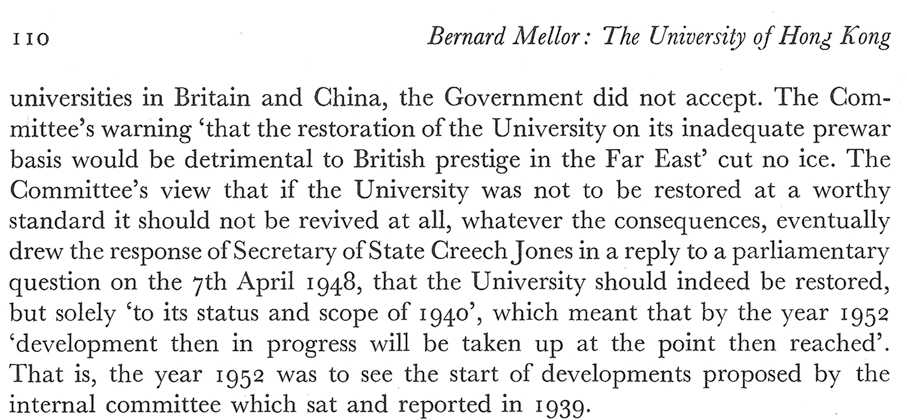

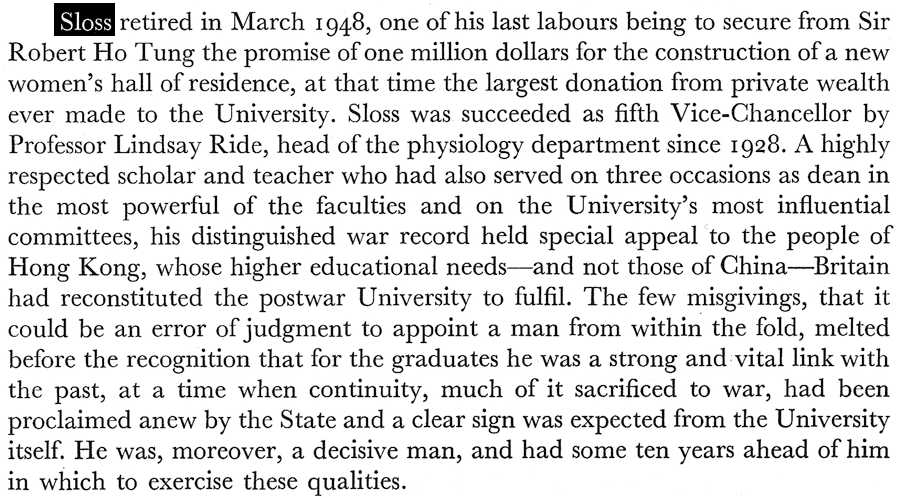
London Gazette 1947
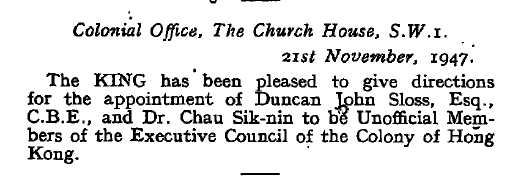
Succeeded as Vice-Chancellor 1948
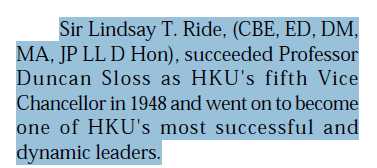
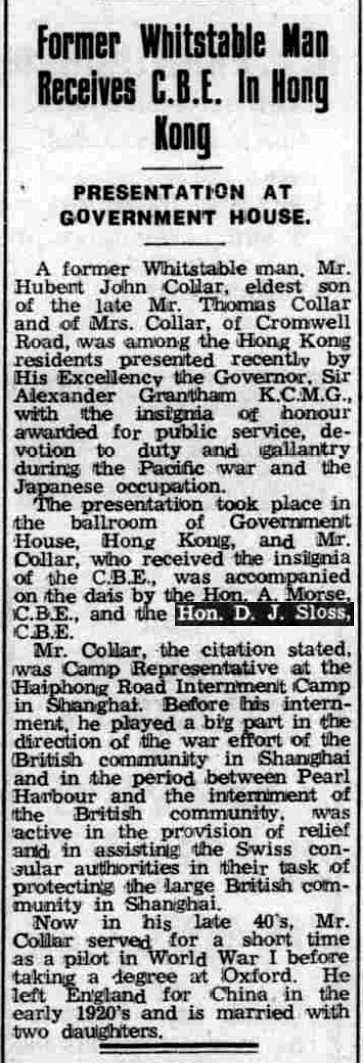
References held at HKU
FO 371/23519. D. J. Sloss. A letter to Beresford, University Grant Committee. Dated 6th July, 1939.
BW 90/585. HKU Advisory Committee. Confidential Note on Salary scales by Mr. Duncan Sloss. [c. 1940]
CO 1045/470. G. A. C. Herklots. "A New Hong Kong University." A memorandum from a report submitted to D. J. Sloss in Stanley Internment Camp, 1945. 1-7.
CO 1045/475. "University of Hong Kong- Present Position." A report by Duncan Sloss. Dated 20th July, 1949.
HK University - Duncan Sloss Building
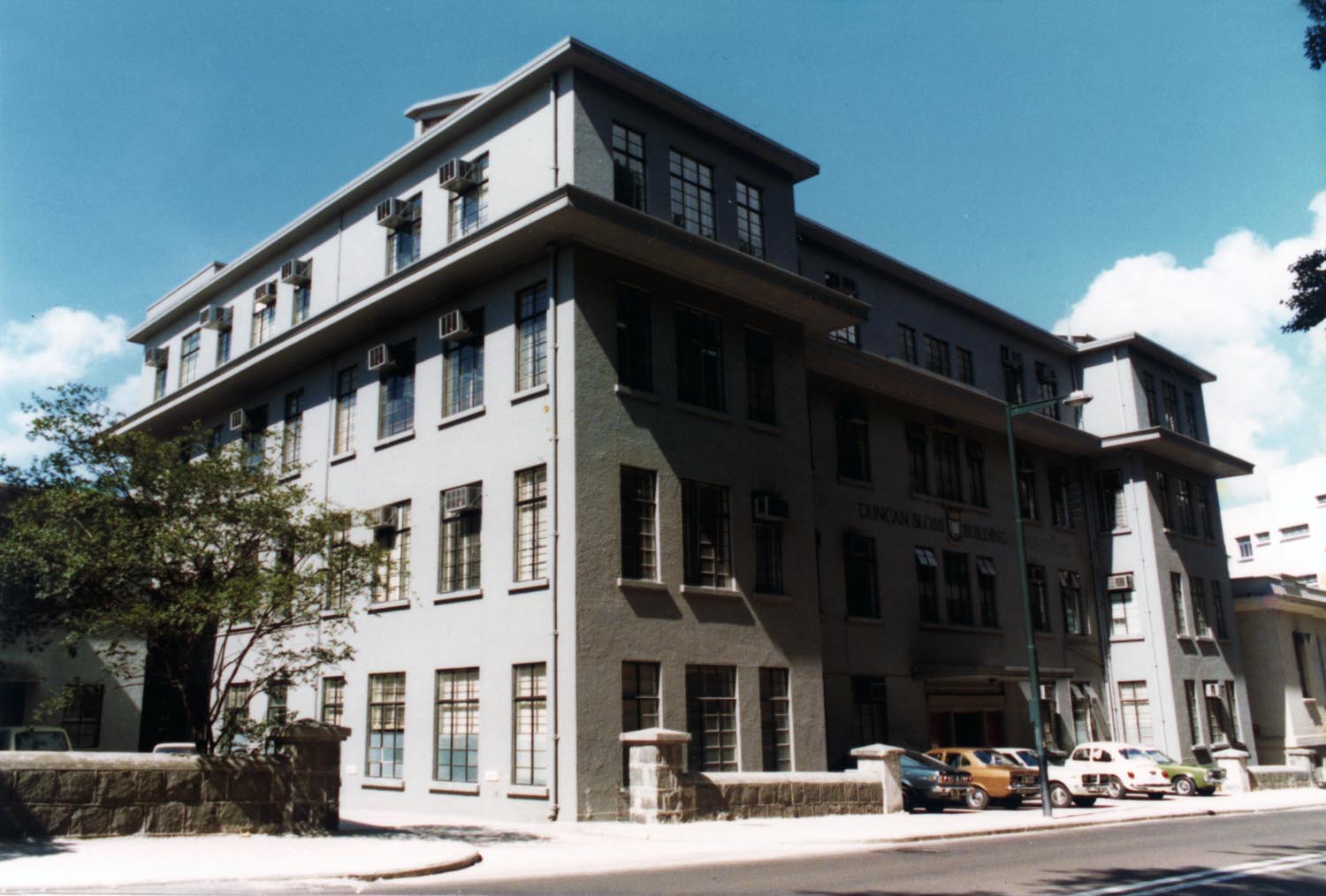


[photos from HKU]
The Duncan Sloss Building was demolished to permit expansion and development of the campus.
Re-Marries 1949
Name: Duncan J Sloss
Spouse: Margaret Scott Watson
Marriage: 4 Apr 1949 - Hong Kong
Mother: Jane Sloss Father: Duncan Sloss
D.J. Sloss passed away in 1964 in Oxford.


The family home at 313 Woodstock Road in Oxford[Google Maps]
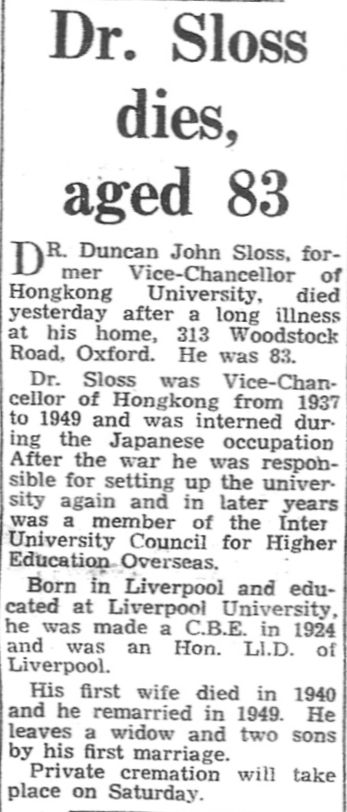
Oxford Mail - Thursday July 30th 1964
Professor Duncan John Sloss CBE MA LLD
(1881-1964)
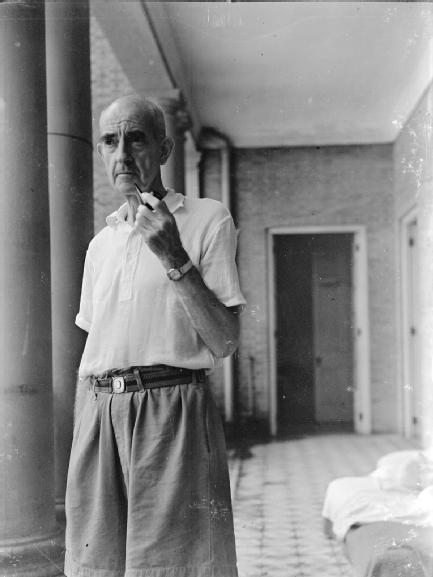
[Photo copyright Imperial War Museum]

All Aliens RFC, Sefton RUFC photographs, programmes and memorabilia Copyright © 2012 Sefton RUFC